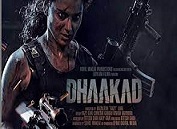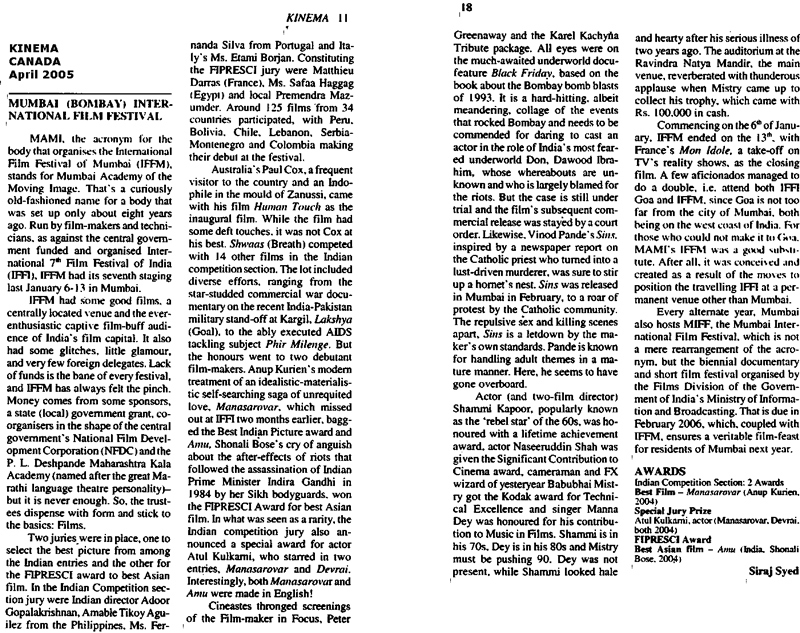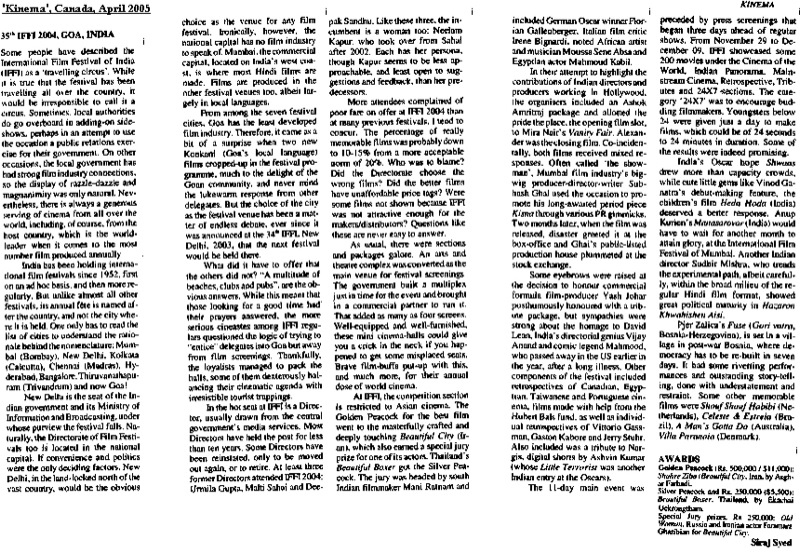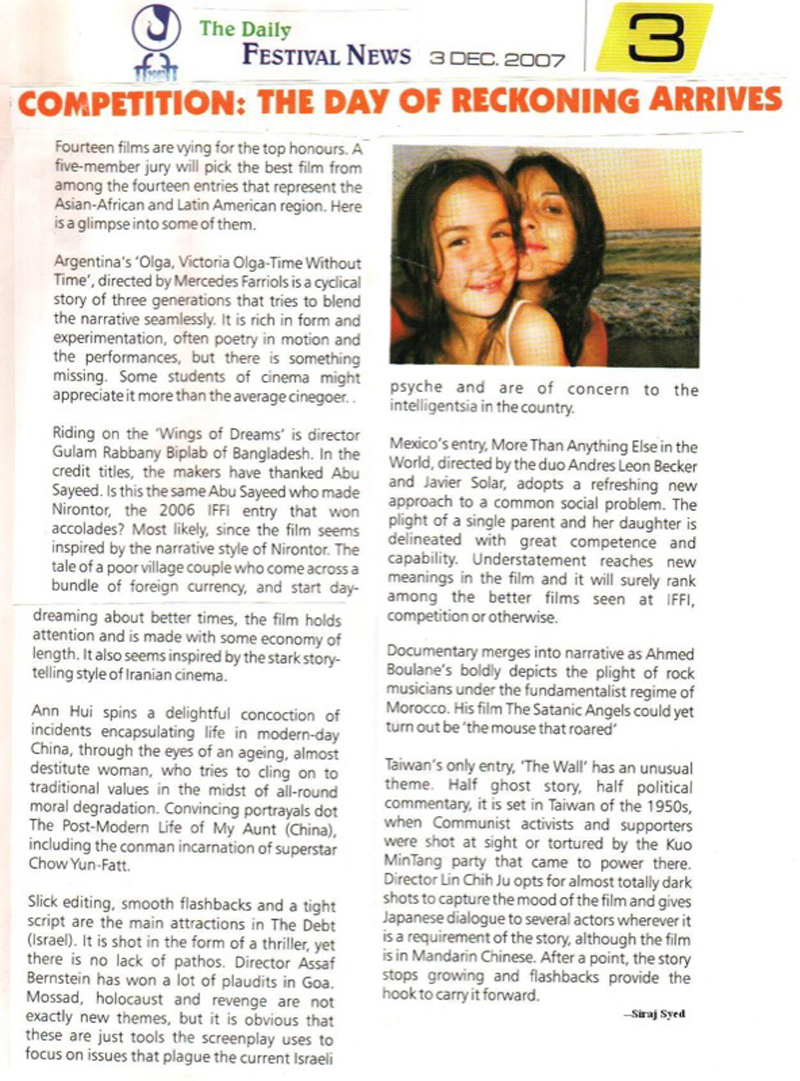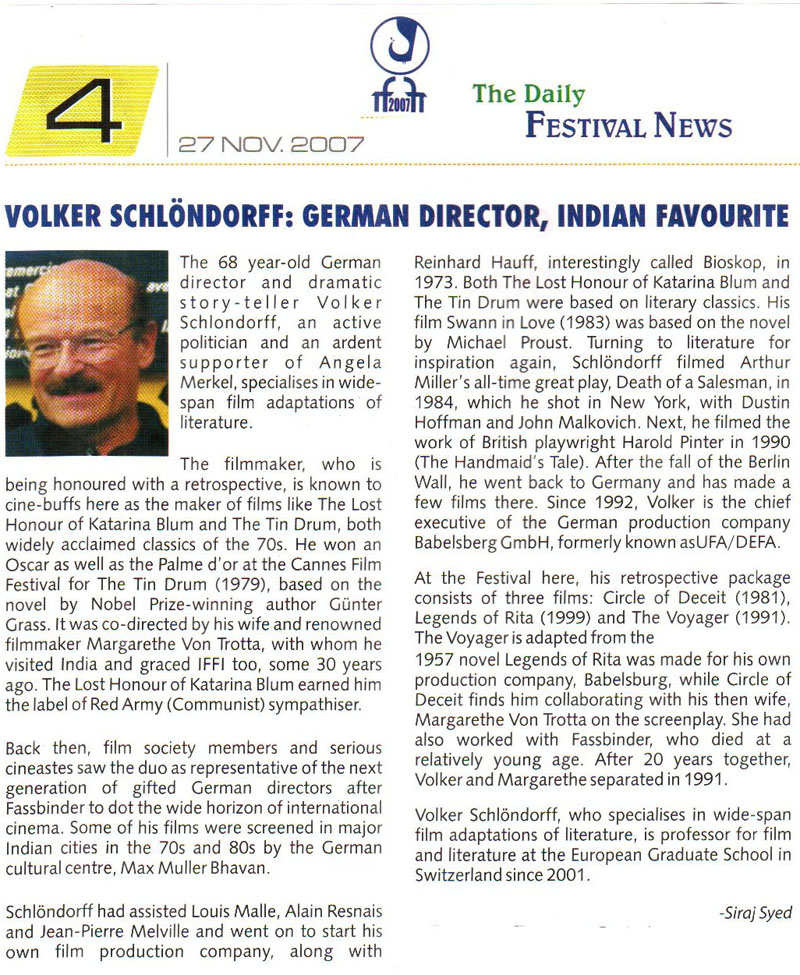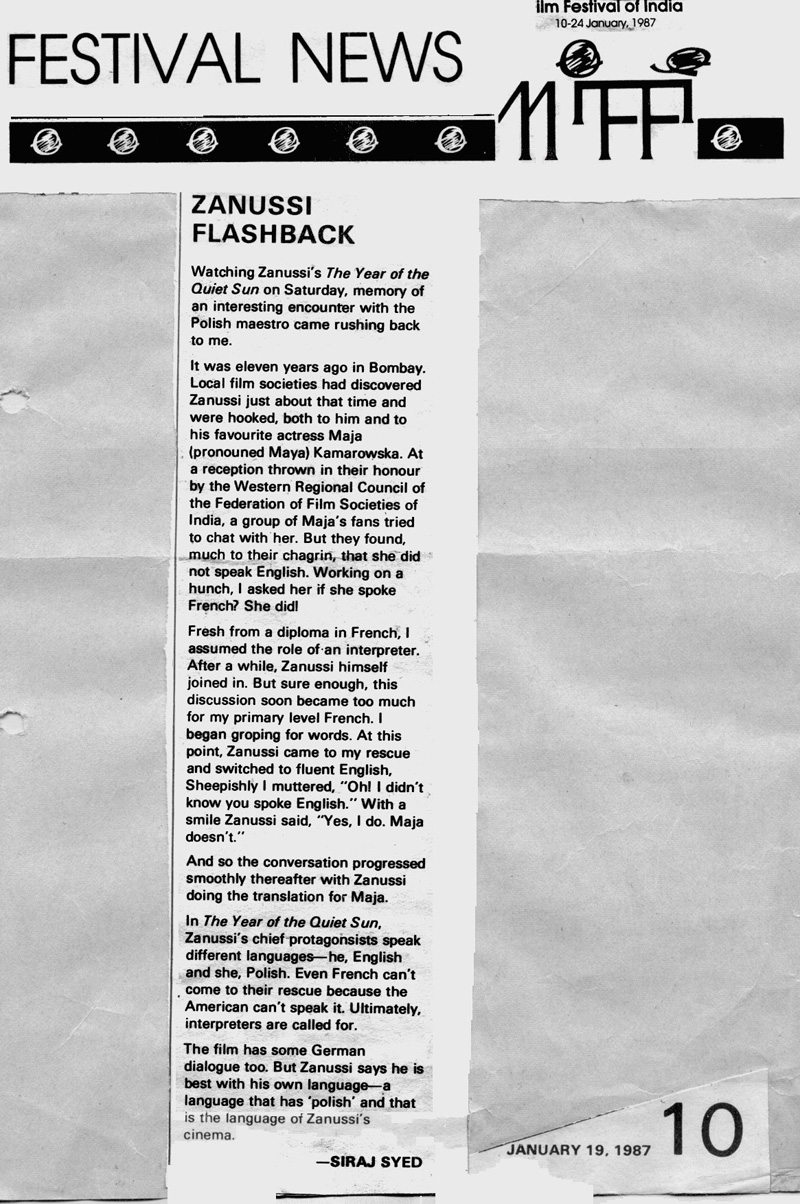|
|
||
|
Pro Tools
FILMFESTIVALS | 24/7 world wide coverageWelcome ! Enjoy the best of both worlds: Film & Festival News, exploring the best of the film festivals community. Launched in 1995, relentlessly connecting films to festivals, documenting and promoting festivals worldwide. Working on an upgrade soon. For collaboration, editorial contributions, or publicity, please send us an email here. User login |
Dhaakad, Review: Kan-gana Ran-aut-do Charlize Theron?
Dhaakad, Review: Kan-gana Ran-aut-do Charlize Theron? Whenever director Razneesh ‘Razy’ Ghai shouted action on the sets of this film, he must have meant either of two things: A. Kangana Ranaut, Arjun Rampal and a battalion of cronies get at each other, either with arms and ammunition, or fists, kicks and ambition. B: Some version of a lullaby is sung by someone, from at least four characters. There is little else happening. So, what? Is something more needed? Yes, surely! But where have you seen such fast and brutal action on the Indian screen, and where have you heard a lullaby being used to….? Wait a minute! It wasn’t exactly a lullaby, but a song united the family, decades after it was scattered, in film called Yaadon Ki Baaraat, released in 1973. Now for the fast and brutal action, and a drinking, smoking female protagonist, with no holds barred, that was the stuff that Atomic Blonde was made of, released in 2017. Dhaakad was announced on 20 October 2020. Both the earlier films were impressive films, notwithstanding that Atomic Blonde was released here in a sanitised version. Guess the writers and director of Dhaakad (Formidable) were more than impressed by these films. So, move over Charlize Theron, aka Atomic Blonde, here comes Kangana Ranaut. On second thought, don’t move over just yet. An orphan raised by a Handler of the Indian International Task Force (ITF), after her parents’ murder, Agent Agni is ruthless in her tactics of dealing with terrorists and criminals. The film begins in Budapest, Romania (Romania is not named, the caption says Budapest, Central Europe), where Agni is sent to ‘extract’ a foreign agent, who could give leads about a human trafficking and prostitution racket involving Indians. Informed by her boss during the mission that the mission has been compromised and should be aborted, she refuses to abort, and continues the battle. She battles a hundred assassins, involving guns, swords, hand and feet, yet fails to bring back the agent alive. Out of mercy, she shoots the agent dead. Agni and ITF then get some information about the mastermind of the racket and its headquarters, and it turns out that the operation is conducted from a coal-mine in Central India. The mastermind of this racket is one Rudraveer, his partner is a woman named Rohini and his right hand is a man named Khalid. Rudraveer is a mysterious character, very rarely seen, who operates from Sohagpur Coal Fields, near Bhopal, Madhya Pradesh, India. Agni is sent to collect information on Rudraveer so that he can be nabbed. Agni is not keen on going back to India, where she has memories of her parents being shot dead in front of her eyes (suggesting that she has lived abroad for many years without ever visiting India), but her Handler persuades her. He warns her, though, that a failure like Budapest will not be tolerated, and also that she will be dismissed from service if she fails. Her brief is to just collect information, with the help of ITF’s local contact, Afzal. Agni, being Agni, has no intention of merely collecting information. Another example of a film written by a writers’ pool, Dhaakad has five writers credited: story by Razneesh ‘Razy’ Ghai, Chintan Gandhi and Rinish Ravindra, screenplay by Razneesh ‘Razy Ghai and Rajiv Menon and dialogue by Ritesh Shah, merging of details obtained from two different websites. The plot of a girl seeing her parents getting killed and living the trauma to grow-up and seek revenge has no novelty whatsoever. And spy action thrillers full of hi-octane action are a dime a dozen. Yet, it must have taken some courage on the part of the writers to develop Agni as a single woman who drinks, smokes, (suggestively) has casual sex, treats her own wounds herself, maintains her own private arsenal, goes into action with her legs and thighs showing, astride a motorcycle, and bounces back after every defeat with rigorous training to get back into action. She is not afraid to disobey her Handler, but has a very human side to her too, which is triggered when she meets Afzal’s young daughter, Zaira. Dialogue is not memorable, except one line that is easy to recall, the reaction of the onlookers when they are told that her heart is not where it should be. To continue the story and the action, the writers have her deeply wounded once and almost dead at least twice. The first time around, she gets a gash on her thigh. She drowns herself in alcohol, washes the wound too with the spirit, and then uses an instrument to extract the bullet and treat the wound. As far as the near death experiences go, both times, it is an incredible sequence of events. She is brutally stabbed on the first occasion, by the dark forces, and yet, the hardened professionals cannot kill her. They leave her for dead, and guess what? She recovers. Not taking any chances when they encounter her on the second occasion, the Head Honcho shoots her in her heart, from very, very close quarters. She collapses, and her ‘corpse’ is left behind. Later, it is airlifted to a hospital. There, a doctor tells the Handler that she will survive, because her heart is not in the normal position, like everybody else’s, and is a bit to the right, a one in millions occurrence So, the bullet missed her heart. Going by the pace of the film, the ‘loree’ (lullaby) that her parents used to sing to her being repeated a dozen times comes as a dampener, especially when adults sing it. In fact, when it came the fourth or the fifth time, and every time after that, the audience jeered loudly. The story is set in present day, but no use of mobile phones is shown, which would have been an essential tool of the trade. Vowing to protect Afzal and Zaira from Rudraveer, Agni makes no attempt to keep in constant touch with them, which would be necessary, since she is often away on missions. Rudraveer’s back-story is not convincing. As a teenager, he resorts to coal smuggling, and when confronted by his moralistic father, he shoots him dead, declaring he has “overthrown the government”. He then forms a gang, but when and how did this coal smuggling gang develop into an international operation involving billions of Rupees and human trade is not written into the screenplay. Why does ITF need a deadly killer, just to collect information? It defies logic. And, to become a spoiler, almost everybody, on either side, is killed in the end. No. no, not Agni. Dhaakad 2 has already been announced, so Madame Atomic Blonde cannot die. Director Ghai has used Romania and Madhya Pradesh as locations because, I am sure, he got shooting incentives and other sops from them, as the credit titles read. There was no other logical reason for setting the action in these two places. India’s biggest coal mines are in the Eastern State of Jharkhand, but perhaps the government there was not willing to offer sops, or their political dispensation was different from that of the film unit. It speaks poorly of the ITF and Indian diplomats if a wounded Indian operative in Romania, or India, for that matter, has to treat her wounds herself, and undergo a recovery and training routine all alone. Why does she reveal her legs during missions is beyond comprehension! Granted that some Indian songs have become very popular abroad, but when Agni, in disguise, breaks into a Hindi song at a Romanian Night Club, and the local musicians and singers join in, it appears a bit much. She agrees to be picked up by a customer at the bar and has simulated sex on the sofa, before they ask each other the most important question, Your place or mine?” When he comes back with his keys, she is gone. What was the scene all about? And can Agni walk into the open door of her Handler’s house and do what she does, unchallenged? An ITF informer, Afzal appears a stool pigeon, with nothing to protect himself with. When his cover is blown, Rohini just walks into his home, toting a gun, and he falls at her feet, pleading for the life of his daughter and himself. In every fight, Agni gets the maximum battering and grunts loudly every second. Nobody else does. Luckily for her, she wins some of these encounters, or is left for dead. Who uses swords in 2022? A horde of Romanian baddies does. They come in batches, and Agni, after some deft moves, manages to de-sword them, and, in many cases, impale them. The usual face-off between the government ministry and the secret service (ITF) sounds as hollow as they come. A secret agent/spy/assassin going by her orders would be a novelty, where flouting instructions is the norm. When Agni does so, twice, it comes as no surprise at all. Maybe that is his style, for we see the arch-villain fist-fighting most of the time. And when he has his victim in his lap, he only then pulls out a gun and shoots her from close quarters. This is in reverse, compared to traditional villains, and I do not know whether it is a welcome departure or just a whim. Likewise, on some three occasions, somebody puts a gun on somebody else’s temple and the shot is cut there. By experience, you know that the trigger was not pulled. Ladies and gentlemen, the heroine of the film Dhaakad is Kangana Ranaut, winner of four National Film Awards and five Filmfare Awards. She has also featured six times in Forbes India's Celebrity 100 list. In 2020, the Government of India honoured her with the Padma Shri, the country's fourth highest civilian award. This was on the back of Manikarnika: The Queen of Jhansi, Rani Laxmibai, a film that she co-directed too. The film won her both the big awards, Filmfare and National, for the same film. Ranaut identifies with right-wing ideologies, and is a supporter of the ruling part of India and the Indian Prime Minister. Dhaakad was made to showcase her prowess in a genre she had not flirted with in the past. She has a very Indian face, which is often made to look Western, or Middle Eastern with the help of wigs, costume and make-up. In one case, she uses a rubber mask to take on the look of another woman. Except for the few moments when she gets emotional about her late parents and about, the missing Zaira, Kangana does not need to emote. Her voice does not suit the sex kitten image that she projects in many scenes, neither do her grunts sound those of a hardened fighting machine. Well, she played the fighting queen Manikarnika, who lived in the early 19th century and has now played Agni (which means fire), in the early 21st century. That still leaves many centuries and many action heroines to explore and embody. What can you say about Arjun Rampal? I was not impressed with a few of his performances, but here, he goes all out, with no inhibitions. That his model looks make it difficult to accept him as a ruthless, cold-blooded villain and mass murderer is a professional hazard. Divya Dutta has a ball as the foul-mouthed child-prostitute Rohini, who turns Rudraveer’s mistress, and does a little gig whenever she or one of her men, kill someone. There is the faintest trace of, “Should I be doing this?” on one or two occasion, but for the rest, DD is in good form. Sharib Hashmi is endearing as Afzal, with the Bhopali accent to boot. It’s time he got meatier roles. Saswata Chatterjee as the Handler does a reasonable job in an ill-defined role. Names of other artistes were not available. Japanese cinematographer, Tetsuo Nagata, who lives in France, makes Budapest look its best, from all angles, mainly top ones. If, during the fights, it is difficult to distinguish between Agni and her team, and Rudraveer and his retinue, we cannot blame him. There are several factors involved, and photography could just be one of them. It took a long time for Razneesh to persuade Nagata to sign on, and it has proved worth the time and effort. Dhaakad is edited by Rameshwar S. Bhagat, and editing is what gives an action film its pace and rhythm. That’s a good job done. And don’t blame him for the moments when the film drags; they are plot points in the screenplay which he could not possibly excise. One shot seems to be missing, about somebody at a bust stop, to which Kangana refers, while talking to Afzal. Music score by Dhruv Ghanekar and Sneha Khanwalkar is of a high calibre. Songs by Shankar–Ehsaan–Loy, Dhruv Ghanekar and Badshah (end credits, if I recall correctly) suit the film, but fail to linger in your memory, except ‘She’s on fire’. At two hours and 11 minutes, the length is okay, if only the dull, forced emotional bits rare not there. Watch out! Here comes Charlize Theron…or is it the leggy Kangana Ranaut on her superbike? Fans will lap it up. Discerning filmgoers will have strong reservations. But when it comes to ratings here, every film gets what it deserves. Rating: ** Trailer: https://www.youtube.com/watch?v=1XJ5t2maPno 21.05.2022 | Siraj Syed's blog Cat. : Arjun Rampla ATOMIC BLONDE Badshah Bhopal budapest Central Europe Central India Charlize Theron coal foelds Dhruv Ghanekar Divya Dutta five Filmfare Awards Forbes India's Celebrity 100 list Human trafficking Kangana Ranaut Madhya Pradesh Manikarnika: The Queen of Jhansi National Film Awards Padma Shri Rajiv Menon Rameshwar S. Bhagat Rani Laxmibai 2 Razneesh 'Razy' Ghai Razneesh ‘Razy Ghai Rinish Ravindra Romania Saswata Chatterji Shankar–Ehsaan–Loy Sharib Hashmi She’s on fire Sneha Khanwalkar Sohagpur Tetsuo Nagata Yaadon Ki Baaraat Independent FILM
|
LinksThe Bulletin Board > The Bulletin Board Blog Following News Interview with IFTA Chairman (AFM)
Interview with Cannes Marche du Film Director
Filmfestivals.com dailies live coverage from > Live from India
Useful links for the indies: > Big files transfer
+ SUBSCRIBE to the weekly Newsletter Deals+ Special offers and discounts from filmfestivals.com Selected fun offers
> Bonus Casino
User imagesAbout Siraj Syed Syed Siraj Syed Siraj (Siraj Associates) Siraj Syed is a film-critic since 1970 and a Former President of the Freelance Film Journalists' Combine of India.He is the India Correspondent of FilmFestivals.com and a member of FIPRESCI, the international Federation of Film Critics, Munich, GermanySiraj Syed has contributed over 1,015 articles on cinema, international film festivals, conventions, exhibitions, etc., most recently, at IFFI (Goa), MIFF (Mumbai), MFF/MAMI (Mumbai) and CommunicAsia (Singapore). He often edits film festival daily bulletins.He is also an actor and a dubbing artiste. Further, he has been teaching media, acting and dubbing at over 30 institutes in India and Singapore, since 1984.View my profile Send me a message The EditorUser contributions |

















